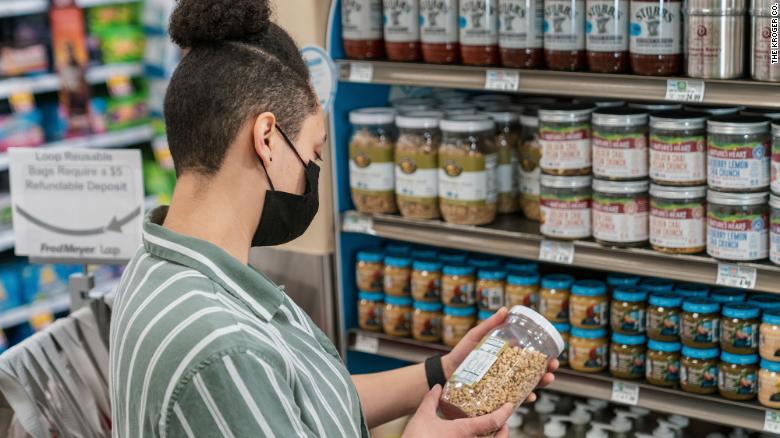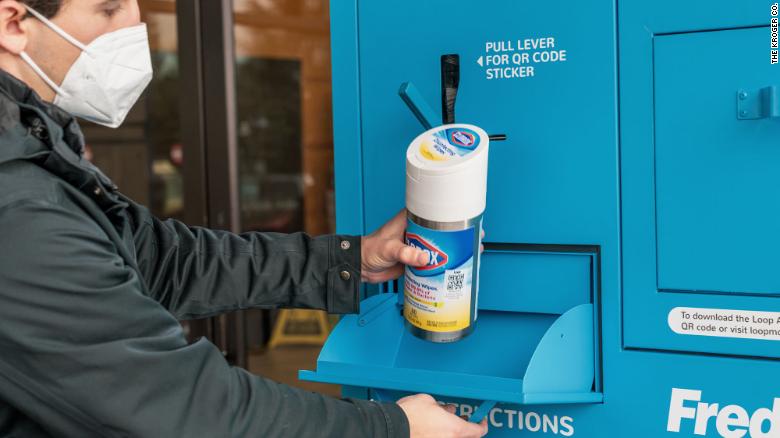Eric Rosenbaum
KEY POINTS
- Terracycle and Loop founder and CEO Tom Szaky says the economics of the recycling business are broken in key ways, but consumer and corporate interest in building a circular economy continues to grow.
- Low oil prices, bans on imported recyclables in countries like China, and the latest trends in packaging design make it harder to recycle.
- Still, the recycling CEO says getting to a low-waste or even zero-waste economy is the way the world once was and can be again.
Recycling may make you feel better in a very small way about your role in helping to avert a global apocalypse, but even in “friendly” places, from John Oliver to NPR podcasts, recycling, especially of plastics, is being given a hard look. More people are wondering: Does it work?
The debate is not new. For years the economics of plastic recycling have been questioned. But the problem is not going away. The globe is already producing two trillion tons of solid waste a year and is on pace to add more than a trillion more on an annual basis in the coming decades, according to World Bank data. A recent study found that the 20 top petrochemical companies in the world, among the group Exxon Mobil and Dow, are responsible for 55% of the world’s single-use plastic waste, and in the U.S., specifically, we are
generating about 50 kilograms of throwaway plastic a year, per person.
The Covid pandemic has heightened attention to the issue, as use of disposable goods went up anywhere from 30% to 50%, according to Tom Szaky, CEO of recycling companies Terracycle and Loop, who joined CNBC’s Leslie Picker on a recent
CNBC Evolve Livestream about sustainability and business. He says concerns about the macroeconomics of waste management systems suffering economically are real, and there are ways to solve it that don’t just rely on government. We all need to take a deeper look at how we recycle beyond the feel-good blue bin, and what we can do to get past the problems.
1. The economics of recycling are broken.
Szaky says recent reporting on the economic issues for plastics recycling and restrictions around the world on imported recyclables, which are both weighing on the sector, are not an anti-environmental attack but “absolutely rooted in facts.”
He says it is important for consumers to understand that just because you recycle an item does not mean it will be recycled in the end.
“What makes something be recycled in a country doesn’t have to do with what we normally think: Can it be recycled? Most of the things we put in blue bins that are not recycled are put in the garbage because they are things waste companies can’t make money off, and that is the true bottleneck,” he said.
The right question is “Can a garbage company, the actual company in charge of the recycling in the geography, recycle it at a profit?”
According to Szaky, what’s happened is a profitability model that is decreasing as oil prices have gone down, which started in 2015, and even after a commodities market recovery post-Covid, have stayed down relative to recent history. The petrochemicals companies that make plastics rely less on recyclables when the price of their core commodity, oil, is lower. Second, China stopped importing recyclable waste, a move followed by other countries in 2018.
Both issues are critically important to the business model of recycling and the health of the infrastructure because they circle back around to how much demand there is to collect those material types.
“And it all hurt the business construct for recycling companies and that means our recycling capabilities are deteriorating,” Szaky said. “Recycling is not out there trying to do the best it can but maximize profit and we need to think about that as we aim for a more circular economy,” he said.
2. A packaging industry mega trend is working against recycling
The biggest global trend in packaging is not helping. Efforts to reduce costs in products and packaging are “objectively reducing value” Szaky said, “which also makes them less recyclable.”
The “lightweighting” of packages, making them have less physical material and more complexity as a result of that design challenge, makes them less profitable to recycle.
All of these economic issues lead to a situation in which what people would like to see is not what they would actually see if they went behind the scenes in the recycling industry. But Szaky says at the same time, consumers want to recycle more, and more companies are leaning into their own recycling.
What companies decide to do about recycling on their own initiative — and pay for — can be done in spite of the challenging economics and can still pay off for the companies in the future. That’s the Terracycle business model, working with companies to fund their own voluntary recycling efforts. And that is more important at a time when the economics of consumer recycling are a mess.
3. Why companies don’t recycle enough, but should more
Szaky says what’s really important right now is companies deciding to lean in and create their own recycling programs. But he says it is still not easy for the corporate mindset to embrace.
“As a retailer or brand, if you just frame it as ‘the right thing to do’ the funding will be small and sporadic because there is no P&L logic to do it. But if you can use it to drive foot traffic like Walmart with car seats or Staples with pens, it can be monetizable,” he said.
Brands that run their own recycling programs should be doing it as part of a plan to drive more market share and brand preference. And he says it becomes “monetizable in a recognizable way” the bigger they become and the faster they can grow. “That is true for any sustainability measure a company is looking to implement in the short term.”
Some products won’t be recycled unless companies are the recycler.
A dirty diaper or toothbrush or cigarette is not recyclable because it costs too much. It is another economic problem, not a physics or chemistry one.
Terracycle recently launched a diaper recycling program in Holland and now it is expanding to many countries.
“Diaper recycling doesn’t make sense from an economic perspective. It is expensive to collect and process,” Szaky said. But for the company that leads, “it can drive core value maybe better than TV ads,” he added.
Consumers want to do the right thing, and companies may want to do the right thing as well in acknowledging an environmental crisis — and fund a feel-good marketing campaign — but Szaky stressed that they need to see “not just the right thing, but that it will pay back.”
Szaky’s other business, Loop, which works with companies on circular economy production, recently teamed with a luxury watchmaker on the world’s tallest landfill: Mt. Everest. The mountain is littered with oxygen tanks from previous climbs and the watchmaker was able to both clean up the mess, an expensive undertaking, and source metal for its watches, which may add to the story it sells consumers in a way competitors can’t match.
4. The real solution is obvious: Consuming less
The white elephant, the fundamental answer to the challenge, is modulating consumption downward, but Szaky says that is a hard one for the business world to champion. “It is fundamentally de-growth.”
Loop, even working with companies to create products from recyclables and where the recycling is part of the product story and selling point, “is not the answer to the garbage problem,” he says.
It may be among the best ways to manage waste in a circular economy, but Szaky says we will need to aim to go back to a world where garbage doesn’t exist.
“Before the 1950s, we received milk from the milkman and mended clothes and cobbled shoes,” he says.
Reuse does still exist at scale today in certain markets, such as beer kegs and propane tanks, but not nearly enough, and without the convenience of an infrastructure which makes return easy and widespread. That is one of the keys he sees for the future.
5. Reusable versus recyclable
While the goal of zero waste is ambitious, it is realistic to imagine a world in which more consumer products become reusable, if they can be easily returned in the circular economy.
Reusable versions of products from Nestle, Procter & Gamble, Kroger, Walgreens, and hundreds of other retailers are being, or will in the future, be made available to consumers.
We can switch a consumer who maybe doesn’t even care about sustainability and that’s frankly the most important. We need to bring everyone along, not just people who view this as a high-passion project.
Szaky envisions the buy-and-return-anywhere model as a key one for the future.
“Buy your favorite shampoo bottle in a reusable form at a Walgreens in New York and drop it off at Burger King and buy an Impossible Whopper in reusable packaging too, and drop that off somewhere else.”
This model can help solve a big problem: consumer behavior. Szaky says while there is a significant consumer market motivated by environmental concerns and consumption, for the recycling industry to really work it needs to avoid relying on the most-motivated consumers. Even plastic recycling that is economic today, such as soda bottles, only results in 1 in 4 bottles being recycled. The No. 1 goal for most consumers will remain convenience and value.
A reusable package is an upgrade over a disposable package in an objective way, and with the convenience of drop-off locations it can lead to an easier shift in behavior, but it has to be offered at the right value to consumers. “With all three things coming together we can switch a consumer who maybe doesn’t even care about sustainability and that’s frankly the most important,” Szaky said. “We need to bring everyone along, not just people who view this as a high-passion project.”
6. Economics are busted but the recycling mindset matters
For all the debate over recycling and the hard facts about its economics, Szaky says there is a reason we talk about it so much.
The individual journey with sustainability always begins with recycling. And that remains key and a reason to figure out how to fix its short-term and long-term challenges.
When people start recycling, it does open the pathways to a broader change in mindset.
“It may lead to a plant-based diet instead of animal protein, or a smaller life, or biking ... creating even more important outcomes,” he says. “But first we have to solve the business problem.”





